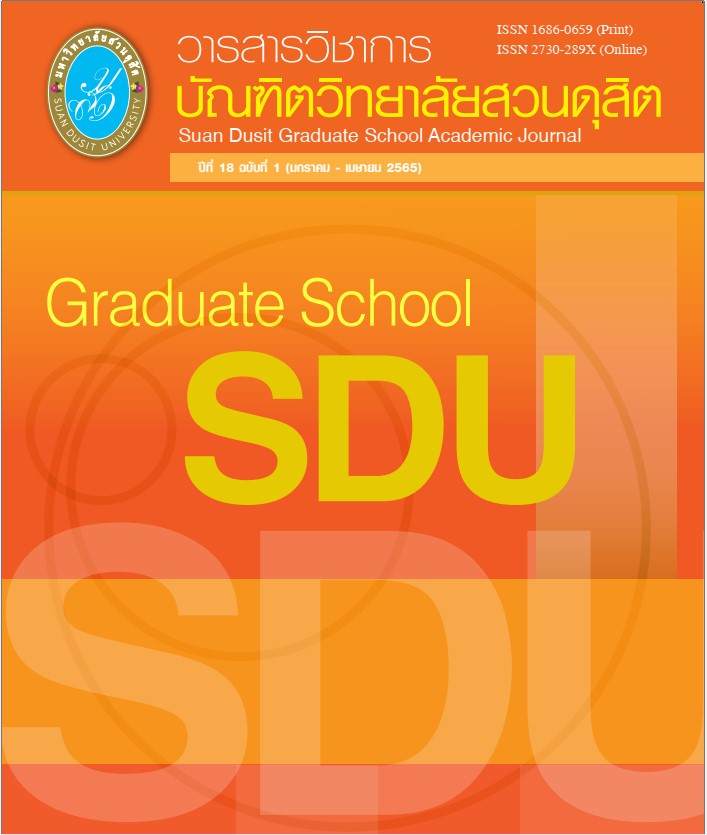Quantification of Human DNA from Mosquito Blood Meals by Real-Time PCR Technique
Keywords:
Mosquito, DNA, Real-Time PCRAbstract
This research aimed to estimate the time; 0, 24, 48 and 72 hours that elapsed since feeding from the degree of human DNA digestion in mosquitoes blood meal by Real-Time PCR technique. The experimental research was performed using QuantStudio™ 6 Flex Real-Time PCR System to quantitate the blood’s human DNA by primers CADM1 (121, 229 and 397 bp). Samples in the experiment were Aedes aegypti, Aedes albopictus and Culex quinguefasciatus. The statistical analysis and hypotheses testing were conducted with General Linear Model. The results showed that 1) The DNA concentrations of three mosquito species at different time after feeding were significantly different at the statistical significance level of 0.05 (F = 13.906, p value= 0.000) 2) The DNA concentrations of three mosquito species were also significantly different at the statistical significance level of 0.05 (F=4.623, p value=0.018). 3) The analysis of the quality of remaining DNA revealed that it can increase in any period of time. In conclusion, the amounts of DNA decreased gradually over time and the mosquito species had different remaining DNA. The acquired DNA had quality enough for further forensic examination. It can track down persons who were related to crime scene and limit of the number of suspects resulting in judicial process rapidly, correctly and reliably. Besides, it can be effective evidence for analysis.
References
เคมอิน อินคอร์โปเรชั่น. (2565). ความรู้เกี่ยวกับเรื่องของยุง. [Online]. Available: https://www.cheminpestcontrol.com/products/product-38. [2565, มีนาคม 24].
จุฬารัตน์ นุราช. (2544). “การศึกษาประสิทธิภาพของโลชั่นกันยุงจากน้ำมันหอมระเหยที่สกัดจากดอกดาวเรือง.” วิทยานิพนธ์ปริญญามหาบัณฑิต สาขาวิชาเทคโนโลยีการวางแผนสิ่งแวดล้อมเพื่อพัฒนาชนบท มหาวิทยาลัยมหิดล.
ไทยรัฐ. (2564). คุมมือฆ่าสาวโรงงานทำแผน ถูกรุมประชาทัณฑ์น่วม. [Online]. Available: https://www.youtube.com/watch?v=3RKTg3rlAfQ. [2565, มีนาคม 23].
วรวุฒิ เจริญศิริ. (2557). ความรู้เกี่ยวกับยุง. [Online]. Available: http://61.7.231.171/epidem/knowladge/mosq.pdf. [2565, มีนาคม 23].
สราวุธ เบญจกุล. (2550). หลักฐานทางนิติวิทยาศาสตร์กับกระบวนการยุติธรรม. [Online]. Available: https://mgronline.com/daily/detail/9500000087821. [2565, มีนาคม 23].
ไอราพต โพธิ์แหบ. (2565). การปฏิบัติการฉุกเฉินในพื้นที่เกิดเหตุอาชญากรรม. [Online]. Available: https://www.emo1.org/single-post/การปฏิบัติการฉุกเฉินในพื้นที่เกิดเหตุอาชญากรรม. [2565, มีนาคม 23].
Applied Biosystems. (2008). Real-Time PCR: Understanding Ct. [Online]. Available: https://www.gene-quantification.de/ab-application-note-understanding-ct.pdf. [2022, April 18].
BCC NEWS. (2008). Mosquito Blood Identifies Thief. [Online]. Available: http://news.bbc.co.uk/2/hi/europe/7795725.stm. [2019, February 7].
Boles, K.S., et al. (2005). The Tumor Suppressor TSLC1/NECL-2 Triggers NK-cell and CD8+ T-cell Responses Through the Cell-surface Receptor CRTAM. BLOOD, 106 (3). 779-786.
Butler, J.M. (2011). Advanced Topics in Forensic DNA Typing: Methodology. Maryland: Elsevier.Hiroshige, Y. et al. (2017). A Human Genotyping Trial to Estimate the Post-feeding Time from Mosquito Blood Meals.” PLOS ONE. 12 (6), 1-18.
NFSTC. (2013). Principles of Trace Evidence. [Online]. Available: http://www.forensicsciencesimplified.org/trace/principles.html. [2020, April 3].
Ponlawat, A. and Harrington, C.L. (2005). Blood Feeding Patterns of Aedes Aegypti and Aedes Albopictus in Thailand. Entomological Society of America. 42 (5), 844-849.
QIAGEN. (2010). QIAamp® DNA Micro Handbook. [Online]. Available: https://www.qiagen.com/us/products/discovery-and-translational-research/dna-rna-purification/dna-purification/genomic-dna/qiaamp-dna-kits/. [2022, April 3].
Siria, D., et al. (2018). Evaluation of a Simple Polytetrafluoroethylene (PTFE)-based Membrane for Blood-feeding of Malaria and Dengue Fever Vectors in the Laboratory. Parasites & Vectors. 11 (1), 1-10.
Spitaleri, S. et al. (2006). “Genotyping of Human DNA Recovered from Mosquitoes Found on a Crime Scene.” International Congress Series. 1288 (6), 574–576.
Taneyhill, L.A. and Adams, M. S. (2008). Chapter 19 Investigating Regulatory Factors and Their DNA Binding Affinities Through Real Time Quantitative PCR (RT‐QPCR) and Chromatin Immunoprecipitation (ChIP) Assays. In Bronner-Fraser, M. (Ed.), Avian Embryology (2nd ed., 367-389). Cambridge: Academic Press.
Downloads
Published
How to Cite
Issue
Section
License
Copyright (c) 2022 Graduate School, Suan Dusit University

This work is licensed under a Creative Commons Attribution-NonCommercial-NoDerivatives 4.0 International License.






